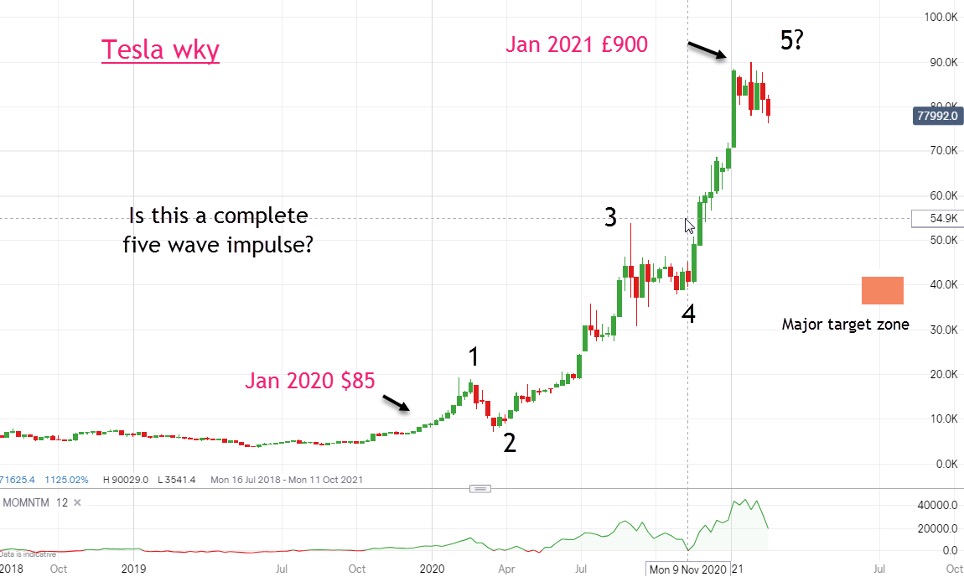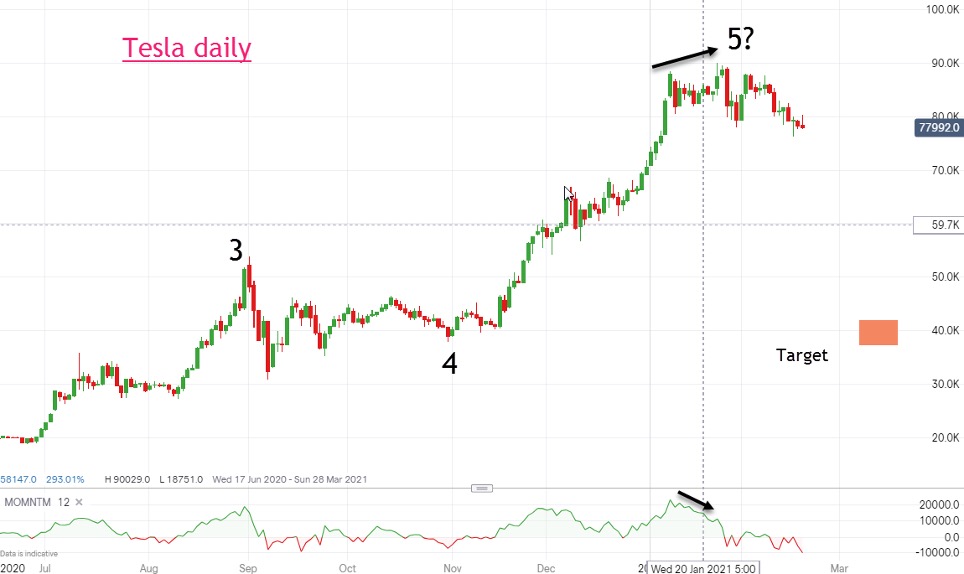Chart of the week: is it time to take profits in Tesla?
The electric vehicle maker’s stock market boom could be stalling, while rivals circle.
22nd February 2021 14:00
by John Burford from interactive investor
The electric vehicle maker’s stock market boom could be stalling, while rivals circle.

When I last covered Tesla (NASDAQ:TSLA) on 2 November, I suggested that the stupendous advance in 2010 – a ten-fold explosion in the share price – was stalling and could be getting to the end of its amazing run. And, since then, the chart behaviour has not dissuaded me from that notion. Far from it – it has augmented my bearish argument.
From the lowly depths under the $100 (£71.23) mark a year ago last January, the advance has been relentless. But even a cursory glance at the chart reveals a clear five-wave pattern to the January high at the round-number $900 print.

Source: interactive investor. Past performance is not a guide to future performance.
According to the Elliott Wave theory a five-wave pattern, when complete, leads to a move in the opposite direction. The difficulty in forecasting the future path of prices is deciding when the final fifth wave has terminated. This can be a very tricky affair – but there are some clues that can be employed.
For instance, does the final fifth wave sub-divide itself into five clear sub-waves? And if there is a momentum divergence leading to the high, it suggests the buying power is waning and the selling pressure is taking over (at least temporarily).
- ii view: will Tesla shareholders keep the faith?
- Backing from Elon Musk’s Tesla sends bitcoin price rocketing
If those conditions are present, then I can gain some confidence in calling the top.
Here is the six-week congestion/reversal pattern on the daily chart. First, I have a clear five-wave subdivision in wave five, together with a momentum divergence into the $900 all-time high. So far, so good.

Source: interactive investor. Past performance is not a guide to future performance.
A note about electric vehicles, or ‘EVs’. The extreme power outage in Texas last week was the result of the freeze-up of the wind turbines that account for 23% of the energy output of that state. With no power available to re-charge batteries, EVs were grounded. Vehicles running on petrol and diesel suffered no such handicap.
Although EVs may be a joy to drive, range anxiety – and now blackouts - remains a real concern. Tesla’s image has not been enhanced by the Texas blackouts affair. Not only that, but Tesla cars are among the most complained-about marque on the road for defects and faults.
With the legacy manufacturers hot on their heels, how much longer can Tesla maintain its current lead?
Prudence suggests taking at least some profits in Tesla, as I suggested in November.
John Burford is the author of the definitive text on his trading method, Tramline Trading. He is also a freelance contributor and not a direct employee of interactive investor.
These articles are provided for information purposes only. Occasionally, an opinion about whether to buy or sell a specific investment may be provided by third parties. The content is not intended to be a personal recommendation to buy or sell any financial instrument or product, or to adopt any investment strategy as it is not provided based on an assessment of your investing knowledge and experience, your financial situation or your investment objectives. The value of your investments, and the income derived from them, may go down as well as up. You may not get back all the money that you invest. The investments referred to in this article may not be suitable for all investors, and if in doubt, an investor should seek advice from a qualified investment adviser.
Full performance can be found on the company or index summary page on the interactive investor website. Simply click on the company's or index name highlighted in the article.
Disclosure
We use a combination of fundamental and technical analysis in forming our view as to the valuation and prospects of an investment. Where relevant we have set out those particular matters we think are important in the above article, but further detail can be found here.
Please note that our article on this investment should not be considered to be a regular publication.
Details of all recommendations issued by ii during the previous 12-month period can be found here.
ii adheres to a strict code of conduct. Contributors may hold shares or have other interests in companies included in these portfolios, which could create a conflict of interests. Contributors intending to write about any financial instruments in which they have an interest are required to disclose such interest to ii and in the article itself. ii will at all times consider whether such interest impairs the objectivity of the recommendation.
In addition, individuals involved in the production of investment articles are subject to a personal account dealing restriction, which prevents them from placing a transaction in the specified instrument(s) for a period before and for five working days after such publication. This is to avoid personal interests conflicting with the interests of the recipients of those investment articles.